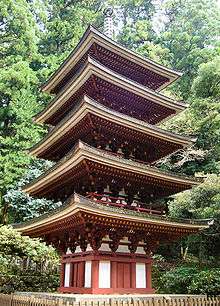Murō-ji

Murō-ji (室生寺) is a temple of Omoto school of Shingon Buddhism, located in the city of Uda, Nara, Japan.
Murō-ji shows its typical aspect of Shingon Buddhism, with its buildings laid on the mountainside of Mount Murō (室生山 Murō-yama).
Unlike many temples of the time, Murō-ji was opened to females. For that reason, the temple is also called Mount Kōya for women.
Overview
While legend has it that the temple was opened by En no Gyōja by order of Emperor Temmu, later restored by Kūkai, an extant record kept by the temple, Murō-ji ryaku engi (室生寺略縁起), tells that a successful ritual in respect of a ryūjin to cure Prince Yamabe's (later to become Emperor Kammu) made the imperial court order a monk of Kōfuku-ji named Kenkyō (賢璟) to construct a temple on the site. The construction of the temple was taken over by a pupil monk Shūen (修円), after Kenkyō's death in 793.
Among the buildings that remain from the ninth century is the five-storied pagoda, which is the smallest of the kind standing in the open air. The pagoda suffered major damage in a 1998 typhoon, when a falling tree struck it. It was restored over the following two years.
In Edo period, the temple buildings were repaired by donation of Keishō-in, mother of Tokugawa Tsunayoshi.
About a kilometer east of the temple is located Ryūketsu Shrine, enshrining the ryūjin.
See also
- Zennyo Ryūō
- List of National Treasures of Japan (temples)
- List of National Treasures of Japan (paintings)
- List of National Treasures of Japan (sculptures)
- For an explanation of terms concerning Japanese Buddhism, Japanese Buddhist art, and Japanese Buddhist temple architecture, see the Glossary of Japanese Buddhism.
References
- Young, David; Michiko Young; Tan Hong Yew; Ben Simmons; Murata Noboru (2007). The Art of Japanese Architecture. Tuttle Publishing. p. 69. ISBN 0-8048-3838-0.
- Mimura, Isao (三村威左男) (2005). Five-storied pagodas in Japan (日本の五重塔総覧) (in Japanese). Bungeisha. p. 185. ISBN 4-8355-9083-X.
External links
- (Japanese) Murō-ji Temple
Coordinates: 34°32′16.39″N 136°2′26.22″E / 34.5378861°N 136.0406167°E
| Wikimedia Commons has media related to Murouji. |